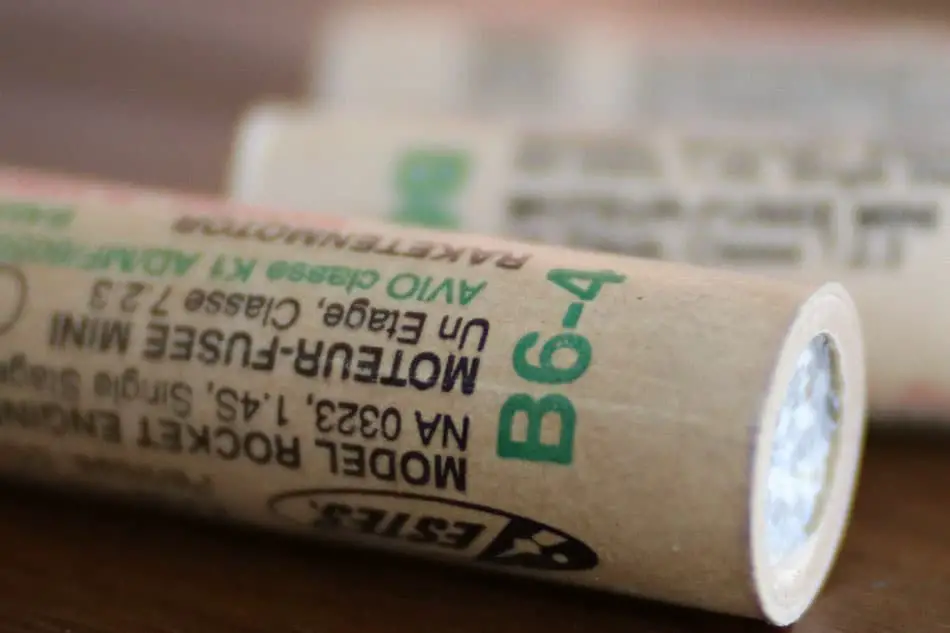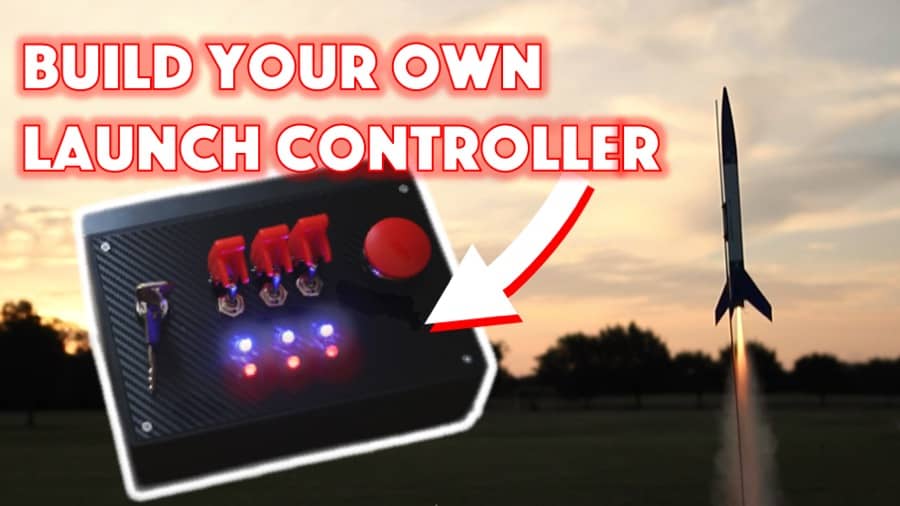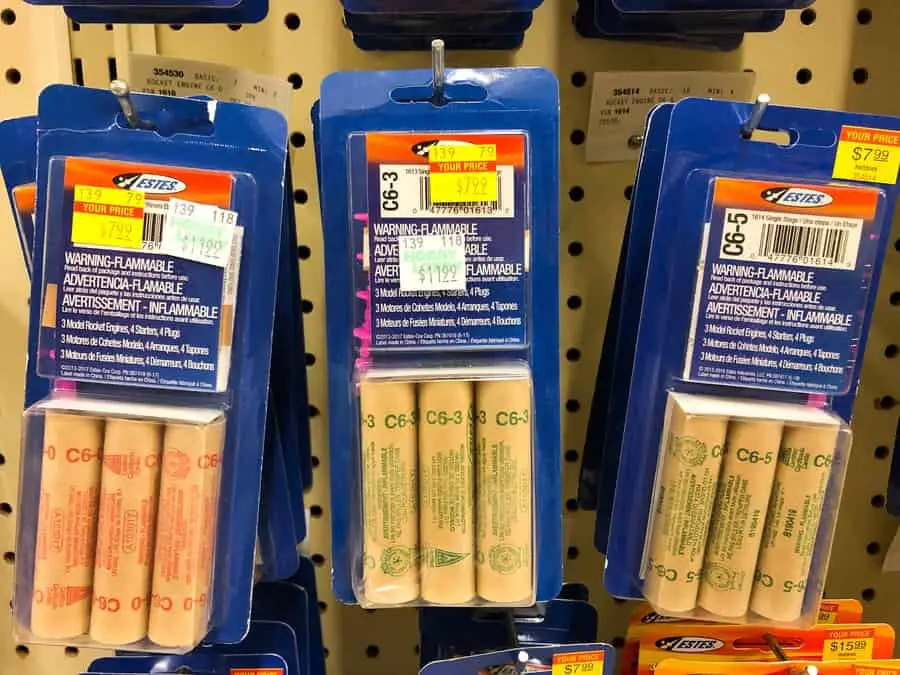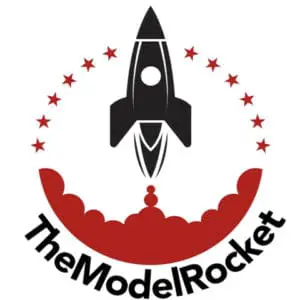
Model rockets are fascinating to a lot of people because at least on a small scale, you can experience the same basic physics that have taken spacecraft to the moon and beyond. And it all starts with the engine.
How do model rocket engines work?
Model rocket engines contain a fuel and oxidizer mix (propellant) that is wrapped in a cylindrical casing. When ignited, the engine ejects exhaust gasses through the engine nozzle and propels the rocket forward. Depending on the design, the engine will usually have an ejection charge to deploy the parachute from the top of the rocket.
That’s the basic answer to “how do model rocket engines work?”, but the way your model rocket engine works will depend on which type of model rocket engine you use.
To learn more about engine styles, propellants, brands, power levels, read on below. I’ve also included some images and links to videos to help you better understand how a model rocket engine works.
Are you still using the standard Estes controllers for your launches?
We just built our own beautiful launch controllers that make launches SO much more fun, and we documented EVERY single step and item purchased and put it into a step-by-step course that teaches you how to do the exact same thing.
Click here to learn more about how you can build your own launch controllers!

How a model rocket engine works step-by-step
Need a little more detail about how a model rocket engine works? Here’s what you need to know.
- Ignite your model rocket engine by inserting an electric igniter into the clay nozzle.
- The electric current ignites the propellant and it burns.
- As the propellant burns, it ejects high-pressure gas.
- The gas escapes out of the clay nozzle and produces thrust, propelling the rocket forward.
- Once the propellant is consumed, the smoke or delay charge, which lies behind the propellant, begins to burn.
- The delay charge produces a smoke trail to help you keep an eye on your rocket.
- The delay charge helps the rocket coast to its maximum height for a few seconds.
- Once the delay charge is exhausted, the ejection charge fires.
- The ejection charge pressurizes the rocket and ejects the parachute or similar recovery device.
- Your rocket floats to the ground. Time to go find it!
Are there different types of model rocket engines?
Most model rocket engines consist of a solid propellant, designed for one-time use. However, there are multiple types of model rocket engines.
To learn more about model rocket engines, you should explore single-use vs. reloadable engines, liquid vs. solid fuel, black powder vs. composite engines, and different model rocket engine brands.
Single Use vs. Reloadable
There are three types of model rocket engine motors: single-use, loadable, and reloadable. Here are the pros and cons to each of them.
Single-Use Model Rocket Engine
- More expensive overall
- Easier to assemble and use
- Usually what you find in hobby shops
- No age requirement or restriction
Loadable Model Rocket Engine
- Close in price to single-use model rocket engines
- Assembly required and trickier than single-use engines
- Composite propellant only (more on this later)
- Age 18+ only
Reloadable Model Rocket Engine
- Lower cost per flight
- Assembly required with more steps than other engines
- Usually requires special order (not found in hobby shops)
- Age 18+ only
Solid vs. Liquid Fuel
Does your model rocket engine utilize solid or liquid propellant?
In a “solid” rocket, the fuel and oxidizer combine to form a solid propellant, stored in a cylinder within the rocket body. The solid propellant burns when exposed to an external source of heat, like an igniter.
When solid propellant burns, the exhaust escapes and propels the rocket. A “flame front” moves into the propellant until it is all burned up.
Liquid-fuel propellants consist of fuel and oxygen in a liquid form, which are combined in a combustion chamber and then ignited. The rocketeer can actually control the amount of thrust produced. They can also manipulate the fuel flow and the engine itself.
Solid Propellant
- Easier to handle
- Rocketeer cannot stop the engine once ignited
- Can sit for years without firing
- Fuel and oxygen are pre-mixed
- Cheaper
- Less efficient and reduced control
Liquid Propellant
- Heavier and more complex
- Rocketeer can stop the thrust by turning off the fuel
- Must be loaded immediately prior to launch
- Must be mixed in a combustion chamber
- More expensive
- Rocketeer can control thrust, engine, and fuel flow
Source: NASA
Black Powder vs. Composite Engines
Simply put, black powder engines are powered by black powder propellant. Composite engines consist of both fuel and oxidizer mixed with a rubbery binder. The main component is Ammonium perchlorate.
Black Powder
Black powder engines are the most commonly used engines in model rockets. They consist of a paper tube with a clay nozzle and a solid pellet of black powder propellant, according to lunar.org.
Black powder is also called gun powder, and consists of charcoal, potassium nitrate, and sulfur. It is cheaper than other propellants, but it does not create as much energy per kilogram of fuel, according to Apogee Rockets.
Black powder engines are:
- Inexpensive
- Easy to find
- Ready to use
However, keep in mind that black powder engines have lower energy density than other engines. They are limited in size options and can only be shipped via HAZMAT shipping.
Composite
Composite engines consist of a fuel and oxidizer combination, which create a chemical reaction when mixed. You can find them in single-use or reloadable styles.
Composite engines are:
- High energy
- Available in virtually all sizes and power levels
- Customizable when it comes to flame color
While composite engines have up to three times the power of black powder by weight, keep in mind that it is more expensive than black powder, can be difficult to come by, and is more advanced to use.
Various Model Rocket Engine Brands
You can find your model rocket in a hobby store like Hobby Lobby or Michaels. There are also plenty of online buying opportunities on sites like Amazon and Apogee Rockets. The brands available to you will depend on where you look.
Are you looking for a black powder or composite engine? What size and power level do you want? Here is some useful information to help you determine which model rocket engine is right for you.
Aerotech: Aerotech is popular and versatile. You can find them in single-use, loadable, or reloadable styles. They come in 18mm D size and up, according to Apogee Rockets. This is a high-power motor that is more accessible than other brands.
Estes: You can find Estes engines everywhere, no special online order needed. It is one of the best options for beginners. Most Estes engines use black motor propellant, but there are a few models with a composite propellant.

Quest: Quest engines are comparable to Estes, except they are known for longer tails and being even easier to use. However, Estes are usually easier to find. All Quest engines use black powder.
Cesaroni: Cesaroni models utilize composite-reloadable engines. They come with pre-assembled kits to make your composite engine experiences much easier.
These are some of the most popular model rocket brands available. You should choose your brand based on what’s accessible near you and the features you want in your engine.
I recommend Estes or Quest for brand-new rocketeers. For more reading check out our article Best Model Rockets for Beginners.
What are the parts of a model rocket engine?
To really get to know your model rocket’s engine, you’ll need to be familiar with the parts within the engine. Parts vary slightly based on power, size, and brand, but the typical parts of any model rocket engine include:
- The nozzle at one end
- The propellant behind the nozzle (black powder or composite)
- A delay behind the propellant
- An ejection charge at the other end
The engine burns and has a domino-like effect to make your model rocket soar.
When you ignite your model rocket, the propellant burns and produces gas. The gas escapes through the nozzle, and the thrust from the engine spurs the rocket.
When the propellant is all used up, the delay charge begins to burn. The delay charge does not create thrust, but it allows the rocket to coast momentarily to its highest point. The delay charge also creates a stream of smoke so you can better watch your rocket.
When the delay is complete, it ignites the ejection charge, which pushes out the nose cone and the parachute or streamer.
Here’s a great video showing the various parts of the engine:
What are the different sizes of model rocket engines?
Model rocket engines range in size from 6mm to 98mm in diameter.
“Mini” A engines are about 13mm in diameter and 45mm long.
A, B, and C engines are considered “standard” in size. These are about 18mm in diameter and 70mm long.
D and E power engines are about 24mm in diameter and 70mm long but can be even longer.
Mid and high-power engines can be 29mm, 38mm, 54mm, or larger in diameter. Lengths vary based on the brand you choose.
Classifying model rocket engines with letters and numbers
You’ve probably seen letters and numbers describing model rocket engines, and you may be curious about how to decipher these alien categorizations. I did a little research so I too could learn the mysterious language of rocketry.
Letters: Model rocket engines are categorized with a letter A-G based on the thrust, or impulse, that an engine generates. This value is measured in newtons.
An A engine can have an impulse between 1.26 and 2.5 newtons. A newton is the force necessary to accelerate one kilogram at a rate of one meter per second squared.
B engines can have power from 2.6 to 5 newtons.
C engines have an impulse from about 5.1 to 10 newtons.
D engines have a range of power from 10.1 to 20 newtons, and so on.
Basically, a B engine is twice as powerful as an A engine, and you continue to double your power from there.
Why does the power of your rocket matter? Obviously, the power of your rocket determines how fast and how high your rocket will fly.
Consider your goal for your model rocket experience and the location where you will be using your rocket. More powerful can become a problem when you lose your rocket on a stranger’s roof. (Make sure you’re launching in a safe and open place!)
Numbers: A letter isn’t the only way to classify a model rocket engine. You will often see a number following a letter, or even two numbers following the letter. For example, you may have heard of a C4 or a B6-2.
Nar.org published a “Standard Motor Codes” web page that helps us break this system down. A model rocket engine is classified by:
- A letter specifying the total impulse
- A number specifying the average thrust
- A number specifying the time delay between burnout and recovery ejection
The number directly after the letter is the engine’s average thrust in newtons. Thrust is determined by how fast the propellant burns. For example, a B4 engine burns slower, taking more time to use up its propellant than a B6, which uses all of its propellant in less than one second.
Remember: The smaller the second number, the slower the rocket will fly, because the slower the propellant burns.
The second number, or the number after the dash, is the time that the delay charge burns. If you read the “What are the parts of a model rocket engine?” section, you may remember that the delay charge burns after the propellant burns, and allows the rocket to coast up to its maximum height.
The second number is easy enough to decipher. A B6-2 indicates a two-second delay, whereas a B6-6 indicates a six-second delay, etc.
Here is a chart that will help you determine which type of model rocket engine is appropriate for your skill level:
| Engine class | Power | Skill level |
| 1/2A | .63-1.25 Newton-seconds | 1 |
| A | 1.26-2.50 Newton-seconds | 1 |
| B | 2.51-5 Newton-seconds | 1 & 2 |
| C | 5.01-10 Newton-seconds | 1, 2, 3 |
| D | 10.01-20 Newton-seconds | 2 & 3 |
| E | 20.01-40 Newton-seconds | 3 & 4 |
| F | 40.01-80 Newton-seconds | 4 |
| G | 80.01-160 Newton-seconds | 4 |
Keep in mind:
- A-G class model rocket engines are used in model rocketry
- H-O classes are used in high-power rocketry and require certification
- O-S classes require further certification and include the largest engines available to amateurs
- S-AH classes apply only to professional rockets, which do not use this nomenclature
What’s my skill level?
Let’s touch on skill level, just in case you’re not sure what type of engine to buy based on your previous experience. For a really great resource with more comprehensive information on skill level, check out Apogee Rockets’ “Measuring Your Skill Level” page.
Keep in mind that your skills should build upon the previous levels’ skills, so if you have level three skills, you should also have all skills mentioned in level two and level one.
Should I use a low-power or high-power rocket?
“Low-power” rockets can include anything up to an E engine.
“Mid-power” rockets can include D and E engines, but certainly F and G engines.
“High-power” rockets include H engines.
If you’re a beginner with model rockets, pick up a kit at your local hobby store. Read the kit to find out which type or types of engines are suitable for your chosen rocket. You should probably start out with a low-power rocket.
After you fly your first low-powered engine, you can get a better feel for how high and far your rocket will fly, and what kind of engine you want in the future.
Information on restrictions and certifications
Yes, there are some restrictions and certifications when it comes to model rockets and model rocket engines. You might be surprised by how powerful some of these amateur engines are!
Here’s what you need to know about model rocket engine restrictions:
- Anyone can purchase rocket engines classified A-G
- To purchase and operate H or I engines, you must be certified level 1
- To purchase and operate J, K, or L engines, you must be certified level 2
- To purchase and operate M, N, and O engines, you must be certified level 3
How do you become certified as level 1, level 2, level 3, or level 4 to buy and fly some of these more advanced rockets?
To become a level 1 rocketeer:
Step 1: Become a member of NAR (National Association of Rocketry) or TRA (Tripoli Rocketry Association)
You have to become a member before becoming certified for flying H-class engines or higher.
Use the website links above to visit their sites and learn more about becoming certified with them. The first step is to complete the application online.
TRA charges $40/adult for their annual membership, or $50/family. You pay again each year to renew your membership. NAR offers a one-time fee of $1,000 to become a member for life.
Why sign up for NAR? NAR offers:
- $5 million rocket flight liability insurance
- Resources like The NAR Member Guidebook (a how-to book on rocketry) and access to “The Member Resources” website
- Option to become certified for high-power rocketry
- Access to clubs, reports, and six issues of Sport Rocketry magazine
Why sign up for TRA? TRA provides:
- $3 million with primary rocket flight insurance coverage
- Private and active forums where members can ask rocket-related questions
- Access to certification courses so you can advance in rocketry
Step 2: Build your level 1 rocket
If you would like to become level 1, level 2, level 3, or level 4 certified, you must start with your Level 1 certification (and work your way up from there!)
Keep in mind that the rules are different depending on whether you are a member of the TRA or NAR. Here are the links to the TRA rules and procedures and the NAR rules and procedures.
Here are a few things you should know about building your Level 1 certification rocket:
- You have to build your own – you cannot borrow a friend’s, and you cannot work in a group.
- You can build your rocket from a kit or from scratch.
- Your rocket must fly on an H or I engine. However, you may choose to first test your rocket with a G engine before your supervised launch.
- Conduct a supervised launch.
You should acquire one H or I engine and set up an appointment with an official observer. You can find both your engine and your observer through your organization (the NAR or TRA). Check in with your observer before your appointment day to ensure you are both clear on the time and place.
The observer will watch you assemble and launch your rocket. You must then retrieve your model rocket and return it to your observer.
If you lose your rocket or it comes back with significant damage, you will not pass the certification test. If you successfully launch and retrieve your rocket, and it is still flyable, you will pass your certification. Your observer will send you your Level 1 Certification form.
Once you receive your certificate, you can buy and fly H and I category engines.
To become level 2 certified:
Step 1: Build your level 3 rocket
If you would like to become certified to buy and fly a J or K engine, it’s time to build a level 2 rocket and pass another certification test. James Yawn suggests that if you select the right rocket kit and engine, you can complete both your Level 1 and Level 2 certification with the same rocket!
Step 2: Study for a written exam
Before launching your level 2 rocket, you will need to pass a written exam. Your organization offers the guides with the answers you will need to know. As long as you study the given guide closely, you should be able to pass the test without difficulty.
Step 3: Conduct a supervised launch
Make sure your rocket and engine are ready, and your observer knows the right time and place. At the launch, assemble your rocket and launch it off the launch pad. Retrieve your rocket and show your observer that it is still in good condition.
To become level 3 certified:
Step 1: Design and build your level 3 rocket
Design your rocket and then acquire approval from your TRA or NAR technical advisor. You will have to do your research to design a rocket that can successfully fly on an M engine.
Step 2: Plan your launch
Complete your paperwork, such as your Certification Application and your Construction Package Affidavit. Set up an appointment with your TRA or NAR observer and confirm the date and time.
Step 3: Launch your level 3 rocket
The rules are the same as your previous launches, but keep in mind that your engine is far more powerful and the risks are higher. Be confident in the location you select for launch. You will need plenty of space so that you can successfully retrieve your rocket which has flown high and fast into the sky.
When you complete each new certification, a whole new world of rocket power will open to you! The way your rocket soars all depends on the power and size of the engine.
Build Your Own Launch Controller
Don’t forget! You can ditch the stock controllers and confidently build your own from scratch using our step-by-step instructions and exact materials list! We promise this will make your launch experience 10x better, and using our course License to Launch you can be 100% confident you’ll be able to finish this project and be super proud of what you’ve built! Here’s a sneak peek below.
